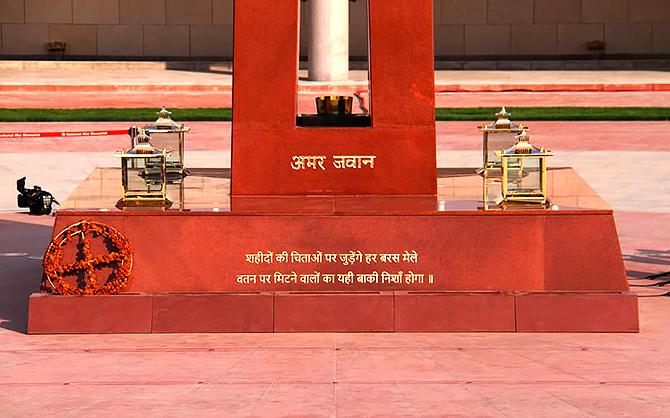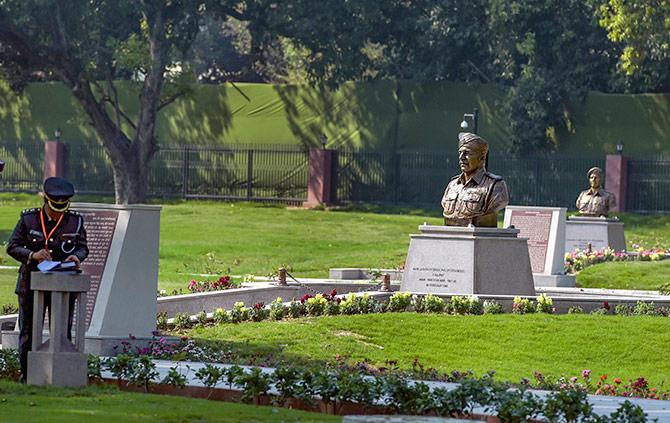Prime Minister Narendra Modi on Monday dedicated the National War Memorial, spread over 40 acres in the India Gate complex in New Delhi, by lighting the flame positioned at the bottom of the stone-made obelisk.
A senior defence official said the project has been executed at a cost of Rs 176 crore and its design was selected through a global competition.
The memorial pays tribute to soldiers who laid down their lives defending the nation during Indo-China War in 1962, Indo-Pak Wars in 1947, 1965 and 1971, Indian Peace Keeping Force Operations in Srilanka and in the Kargil Conflict in 1999.
Here are dome of the glimpses of the memorial.

Drawing inspiration from the 'Chakravyuh' formation, the iconic National War Memorial, boasts of four thematic concentric circles with a tall ceremonial obelisk at its centre that will bear the eternal flame.

The base of the central obelisk bears the famous couplet Shaheed ki mazron par... by poet Jagdamba Prasad Mishra Hitaishi.

The obelisk is topped with an Ashokan Capital.

The names of 25,942 battle casualties have been inscribed across 16 walls that consist of granite pieces bearing the name, rank and regiment of the fallen heroes, the officials said, adding that it was built between February last year and this February in "record time".

The names of soldiers who have made the supreme sacrifice have been inscribed in golden letters on granite tablets arranged in a circular pattern which symbolises the ancient Indian war formation 'Chakravyuh'.

Six bronze murals, made by noted sculptor Ram Sutar, depicting famous battles -- Gangasagar, Longewala, Tithwal, Rizangla, and Operations Meghdoot and Trident -- fought by the army, the air force and the navy have been put up in a gallery in the Veerta Chakra zone.

The memorial also commemorates the soldiers who participated and made supreme sacrifice in the UN Peace Keeping Missions, during Humanitarian Assistance and Disaster Relief Operations, counter-insurgency operations and Low Intensity Capital Operation.

The central part of the sprawling complex has been built in a sunken plot as the design had to respect the heritage look of the India Gate's Central Vista. Chief of Integrated Defence Staff Lt Gen P S Rajeshwar said footfall of about 250 can be accommodated at a time so it will be regulated.

The layout of the memorial located behind the India Gate canopy and across the National Stadium consists of four concentric circles, radially outwards, namely, the 'Amar Chakra' or Circle of Immortality, 'Veerta Chakra or Circle of Bravery, 'Tyag Chakra' or Circle of Sacrifice and 'Rakshak Chakra' or Circle of Protection.

The park is dotted with bronze busts of the 21 awardees, 15 posthumously, of the Param Veer Chakra, country's highest wartime gallantry medal.

The outermost circle i.e. the 'Rakshak Chakra' comprises rows of more than 600 dense trees with each tree representing many soldiers who guard the territorial integrity of the nation round the clock.
With inputs from PTI






















 © 2025
© 2025